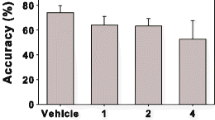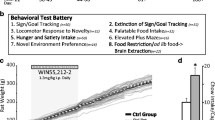Abstract
Rationale
The cannabinoid CB1 selective antagonist SR141716A (Rimonabant) has been shown to decrease body weight in laboratory animals and humans. Furthermore, SR141716A can elicit scratching behavior in rodents, a behavior that has been hypothesized to contribute to SR141716A-induced decrease in food intake. Although childhood obesity is a rising health issue, it is unknown whether SR141716A is equipotent at modulating food intake and other CB1-mediated behaviors in younger subjects.
Objective
To determine whether CB1 receptor blockade is equipotent at modulating food and water intake, body weight, and scratching behavior, the effect of a range of SR141716A doses on these behaviors in food-restricted postnatal day (P) 18, 28, and 60 male rats was investigated. Brain concentrations of SR141716A were determined in each age group.
Results
SR141716A dose- and age-dependently suppressed food and water intake and body weight gain and elicited head scratching, with the most potent effects observed in P18 and P28 rats. Brain concentrations of SR141716A were significantly elevated in P18 rats relative to P28 and P60 rats. SR141716A-elicited head scratching was attenuated by the 5-HT2A/2C antagonist ketanserin.
Conclusions
SR141716A is more potent at modulating food intake and head scratching in very young animals; these differences can be attributed to an increase in brain penetration of SR141716A for P18 but not for P28 and P60 rats. In addition, SR141716-elicited head scratching is modulated by 5HT receptor antagonism and is not a contributing factor to SR141716A's anorectic effects.





Similar content being viewed by others
References
Arnone M, Maruani J, Chaperon F, Thiébot MH, Poncelet M, Soubrié P, Le Fur G (1997) Selective inhibition of sucrose and ethanol intake by SR 141716, an antagonist of central cannabinoid (CB1) receptors. Psychopharmacology 132(1):104–106
Belue RC, Howlett AC, Westlake TM, Hutchings DE (1995) The ontogeny of cannabinoid receptors in the brain of postnatal and aging rats. Neurotoxicol Teratol 17(1):25–30
Bolles RC (1961) The interaction of hunger and thirst in the rat. J Comp Physiol Psychol 54:580–584
Cizek LJ, Nocenti MR (1965) Relationship between water and food ingestion in the rat. Am J Physiol 208:615–620
Cook SA, Lowe JA, Martin BR (1998) CB1 receptor antagonist precipitates withdrawal in mice exposed to Delta9-tetrahydrocannabinol. J Pharmacol Exp Ther 285(3):1150–1156
Darmani NA, Pandya DK (2000) Involvement of other neurotransmitters in behaviors induced by the cannabinoid CB1 receptor antagonist SR 141716A in naive mice. J Neural Transm 107(8–9):931–945
Després JP, Golay A, Sjöström L (2005) Rimonabant in Obesity-Lipids Study Group. Effects of rimonabant on metabolic risk factors in overweight patients with dyslipidemia. N Engl J Med 353(20):2121–2134
Di Marzo V, Goparaju SK, Wang L, Liu J, Bátkai S, Járai Z, Fezza F, Miura GI, Palmiter RD, Sugiura T, Kunos G (2001) Leptin-regulated endocannabinoids are involved in maintaining food intake. Nature 410(6830):822–825
Dvorak M, Watkinson A, McGlone F, Rukwied R (2003) Histamine induced responses are attenuated by a cannabinoid receptor agonist in human skin. Inflamm Res 52(6):238–245
European Medicines Agency Acomplia European Public Assessment Report (2009) http://www.emea.europa.eu/humandocs/Humans/EPAR/acomplia/acomplia.htm
Gardner A, Mallet PE (2006) Suppression of feeding, drinking, and locomotion by a putative cannabinoid receptor ‘silent antagonist’. Eur J Pharmacol 530(1–2):103–106
Gueudet C, Santucci V, Rinaldi-Carmona M, Soubrié P, Le Fur G (1995) The CB1 cannabinoid receptor antagonist SR 141716A affects A9 dopamine neuronal activity in the rat. Neuroreport 6(10):1421–1425
Janoyan JJ, Crim JL, Darmani NA (2002) Reversal of SR 141716A-induced head-twitch and ear-scratch responses in mice by delta 9-THC and other cannabinoids. Pharmacol Biochem Behav 71(1–2):155–162
Järbe TU, Andrzejewski ME, DiPatrizio NV (2002) Interactions between the CB1 receptor agonist Delta 9-THC and the CB1 receptor antagonist SR-141716 in rats: open-field revisited. Pharmacol Biochem Behav 73(4):911–919
Johansson JO, Jarbe TU, Henriksson BG (1975) Acute and subchronic influences of tetrahydrocannabinols on water and food intake, body weight, and temperature in rats. TIT J Life Sci 5(1–2):17–27
Jourdan D, Piec I, Gaulier JM, Lacassie E, Alliot J (2003) Effect of fenfluramine on caloric intake and macronutrient selection in Lou/c rats during aging. Neurobiol Aging 24(1):67–76
McLaughlin PJ, Winston K, Swezey L, Wisniecki A, Aberman J, Tardif DJ, Betz AJ, Ishiwari K, Makriyannis A, Salamone JD (2003) The cannabinoid CB1 antagonists SR 141716A and AM 251 suppress food intake and food-reinforced behavior in a variety of tasks in rats. Behav Pharmacol 14(8):583–588
McLaughlin PJ, Winston KM, Limebeer CL, Parker LA, Makriyannis A, Salamone JD (2005) The cannabinoid CB1 antagonist AM 251 produces food avoidance and behaviors associated with nausea but does not impair feeding efficiency in rats. Psychopharmacology 180(2):286–293
Miller CC, Murray TF, Freeman KG, Edwards GL (2004) Cannabinoid agonist, CP 55, 940, facilitates intake of palatable foods when injected into the hindbrain. Physiol Behav 80(5):611–616
Neff GW, O'Brien CB, Reddy KR, Bergasa NV, Regev A, Molina E, Amaro R, Rodriguez MJ, Chase V, Jeffers L, Schiff E (2002) Preliminary observation with dronabinol in patients with intractable pruritus secondary to cholestatic liver disease. Am J Gastroenterol 97(8):2117–2119
Oluyomi AO, Datla KP, Curzon G (1994) Effects of d-fenfluramine on feeding and hypothalamic 5-hydroxytryptamine and dopamine in male and female rats. Eur J Pharmacol 255(1–3):175–183
Pavon FJ, Bilbao A, Hernández-Folgado L, Cippitelli A, Jagerovic N, Abellán G, Rodríguez-Franco MA, Serrano A, Macias M, Gómez R, Navarro M, Goya P, Rodríguez de Fonseca F (2006) Antiobesity effects of the novel in vivo neutral cannabinoid receptor antagonist 5-(4-chlorophenyl)-1-(2, 4-dichlorophenyl)-3-hexyl-1H–1, 2, 4-triazole–LH 21. Neuropharmacology 51(2):358–366
Pi-Sunyer FX, Aronne LJ, Heshmati HM, Devin J, Rosenstock J, RIO-North America Study Group (2006) Effect of rimonabant, a cannabinoid-1 receptor blocker, on weight and cardiometabolic risk factors in overweight or obese patients: RIO-North America: a randomized controlled trial. JAMA 295(7):761–775
Rodríguez de Fonseca F, Ramos JA, Bonnin A, Fernández-Ruiz JJ (1993) Presence of cannabinoid binding sites in the brain from early postnatal ages. Neuroreport 4(2):135–138
Rowland ME, Mukherjee M, Robertson K (2001) Effects of the cannabinoid receptor antagonist SR141716 alone and in combination with dexfenfluramine or naloxone on food intake in rats. Psychopharmacology 159(1):111–116
Rubino T, Patrini G, Massi P, Fuzio D, Viganò D, Giagnoni G, Parolaro D (1998) Cannabinoid-precipitated withdrawal: a time-course study of the behavioral aspect and its correlation with cannabinoid receptors and G protein expression. J Pharmacol Exp Ther 285(2):813–819
Scheen AJ, Finer N, Hollander P, Jensen MD, Van Gaal LF, RIO-Diabetes Study Group (2006) Efficacy and tolerability of rimonabant in overweight or obese patients with type 2 diabetes: a randomised controlled study. Lancet 368(9548):1660–1672
Ständer S, Schmelz M, Metze D, Luger T, Rukwied R (2005) Distribution of cannabinoid receptor 1 (CB1) and 2 (CB2) on sensory nerve fibers and adnexal structures in human skin. J Dermatol Sci 38(3):177–188
Szepietowski JC, Szepietowski T, Reich A (2005) Efficacy and tolerance of the cream containing structured physiological lipids with endocannabinoids in the treatment of uremic pruritus: a preliminary study. Acta Dermatovenerol Croat 13(2):97–103
Tallett AJ, Blundell JE, Rodgers RJ (2007) Grooming, scratching and feeding: role of response competition in acute anorectic response to rimonabant in male rats. Psychopharmacology 195(1):27–39
Traynor K (2007) Panel advises against rimonabant approval. Am J Health-Syst Pharm 64(14):1460–1461
Van Gaal LF, Rissanen AM, Scheen AJ, Ziegler O, Rossner S, RIO-Europe Study Group (2005) Effects of the cannabinoid-1 receptor blocker rimonabant on weight reduction and cardiovascular risk factors in overweight patients: 1-year experience from the RIO-Europe study. Lancet 365(9468):1389–1397
Vickers SP, Webster LJ, Wyatt A, Dourish CT, Kennett GA (2003) Preferential effects of the cannabinoid CB1 receptor antagonist, SR 141716, on food intake and body weight gain of obese (fa/fa) compared to lean Zucker rats. Psychopharmacology 167(1):103–111
Wang Y, Lobstein T (2006) Worldwide trends in childhood overweight and obesity. Int J Pediatr Obes 1(1):11–25
Wang L, Liu J, Harvey-White J, Zimmer A, Kunos G (2003) Endocannabinoid signaling via cannabinoid receptor 1 is involved in ethanol preference and its age-dependent decline in mice. Proc Natl Acad Sci U S A 100(3):1393–1398
Ward SJ, Dykstra LA (2005) The role of CB1 receptors in sweet versus fat reinforcement: effect of CB1 receptor deletion, CB1 receptor antagonism (SR141716A) and CB1 receptor agonism (CP-55940). Behav Pharmacol 16:381–388
Williams CM, Kirkham TC (1999) Anandamide induces overeating: mediation by central cannabinoid (CB1) receptors. Psychopharmacology 143(3):315–317
Acknowledgements
The authors would like to thank Jae Daniel Kim and Adedayo Adedoyin for their technical support. This work was funded by NIH grants RO1-DA014673 (EAW) and F32-DA01931 (SJW) and Health Research Formula Fund PA (EAW).
Author information
Authors and Affiliations
Corresponding author
Rights and permissions
About this article
Cite this article
Ward, S.J., Lefever, T.W., Rawls, S.M. et al. Age-dependent effects of the cannabinoid CB1 antagonist SR141716A on food intake, body weight change, and pruritus in rats. Psychopharmacology 206, 155–165 (2009). https://doi.org/10.1007/s00213-009-1592-6
Received:
Accepted:
Published:
Issue Date:
DOI: https://doi.org/10.1007/s00213-009-1592-6




